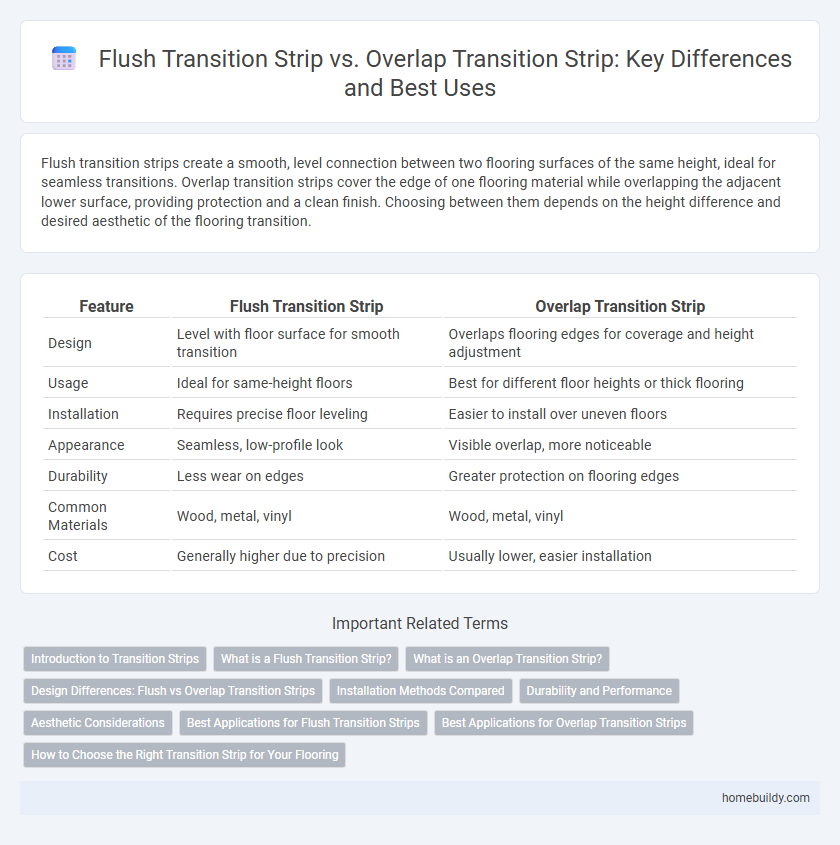Flush transition strips create a smooth, level connection between two flooring surfaces of the same height, ideal for seamless transitions. Overlap transition strips cover the edge of one flooring material while overlapping the adjacent lower surface, providing protection and a clean finish. Choosing between them depends on the height difference and desired aesthetic of the flooring transition.
Table of Comparison
| Feature | Flush Transition Strip | Overlap Transition Strip |
|---|---|---|
| Design | Level with floor surface for smooth transition | Overlaps flooring edges for coverage and height adjustment |
| Usage | Ideal for same-height floors | Best for different floor heights or thick flooring |
| Installation | Requires precise floor leveling | Easier to install over uneven floors |
| Appearance | Seamless, low-profile look | Visible overlap, more noticeable |
| Durability | Less wear on edges | Greater protection on flooring edges |
| Common Materials | Wood, metal, vinyl | Wood, metal, vinyl |
| Cost | Generally higher due to precision | Usually lower, easier installation |
Introduction to Transition Strips
Flush transition strips create a smooth, level connection between flooring surfaces of the same height, enhancing safety and aesthetic continuity in spaces like hallways and open rooms. Overlap transition strips cover the edge of the higher flooring layer, offering protection against movement and damage while accommodating slight height differences. Both types provide essential solutions for seamless flooring transitions, improving durability and visual appeal.
What is a Flush Transition Strip?
A flush transition strip is designed to create a smooth, level connection between two flooring surfaces of the same height, ensuring seamless movement and preventing tripping hazards. It is commonly used where hardwood meets tile or laminate, maintaining an even floor plane without raising one edge above the other. This type of strip enhances aesthetic continuity and provides a clean, unobtrusive finish.
What is an Overlap Transition Strip?
An overlap transition strip is a flooring accessory designed to bridge two surfaces of different heights or materials by overlapping one edge over the adjoining floor. This type of strip creates a smooth, continuous surface that conceals height differences and protects the edges of both floors from damage. Overlap transition strips are commonly used where a higher floor meets a lower one, such as between hardwood and tile or laminate and carpet.
Design Differences: Flush vs Overlap Transition Strips
Flush transition strips align evenly with adjoining floor surfaces, creating a seamless and smooth interface that enhances modern, minimalist aesthetics. Overlap transition strips cover the edge of one flooring type while resting on top of the adjacent floor, providing a raised, protective barrier ideal for handling height discrepancies and preventing tripping hazards. The design difference between flush and overlap strips significantly impacts both visual continuity and functional performance in flooring transitions.
Installation Methods Compared
Flush transition strips require precise measurements and cutting to ensure level flooring alignment, enabling a seamless transition without height variations. Overlap transition strips are installed by securing the strip over the edges of two different floorings, accommodating varying heights but potentially creating a slight lip. Installation of flush strips demands careful subfloor preparation while overlap strips offer simpler adjustment but may require additional adhesive or fasteners for stability.
Durability and Performance
Flush transition strips offer superior durability by creating a seamless, level surface that minimizes tripping hazards and reduces wear from foot traffic. Overlap transition strips excel in performance by providing a flexible cover for height differences between flooring types, but they may wear faster due to exposed edges and movement. Choosing between the two depends on the specific flooring height variances and the expected foot traffic intensity in the area.
Aesthetic Considerations
Flush transition strips create a seamless, level surface between different flooring types, enhancing a modern, minimalist aesthetic. Overlap transition strips add a subtle visual break by covering the edges, which can highlight changes in material and add architectural interest. Choosing between flush and overlap depends on the desired design effect and how prominently the transition is meant to feature in the room's overall look.
Best Applications for Flush Transition Strips
Flush transition strips are ideal for creating smooth, level flooring transitions between rooms with similar floor heights, such as hardwood to tile or laminate to vinyl. They provide a seamless appearance and minimize tripping hazards in high-traffic areas like hallways, living rooms, and offices. Best suited for modern interiors, flush transition strips maintain clean lines and a sleek aesthetic where floor surfaces meet evenly.
Best Applications for Overlap Transition Strips
Overlap transition strips are ideal for flooring installations where two surfaces have different heights, such as between tile and hardwood or laminate and vinyl. They provide a clean, secure edge by overlapping the higher floor, preventing tripping hazards and protecting the vulnerable edges of both materials. Common applications include doorways, stair edges, and rooms with varying floor levels where a seamless, durable transition is necessary.
How to Choose the Right Transition Strip for Your Flooring
Choosing the right transition strip depends on the flooring types and height differences between adjacent surfaces. Flush transition strips provide a smooth, level connection ideal for floors of equal height, enhancing accessibility and a seamless look. Overlap transition strips work best for differing floor heights, protecting edges while creating a gentle slope to prevent tripping hazards.
Flush transition strip vs Overlap transition strip Infographic

 homebuildy.com
homebuildy.com